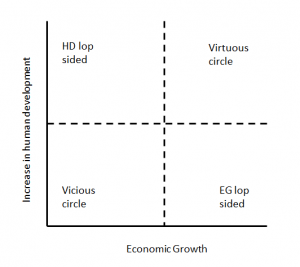Driving over one of the many new bridges in Egypt, part of a massive infrastructure investment programme, we saw a woman sweeping the road as cars sped by. I commented to my wife ‘that’s a dangerous job’. As we passed I saw she was sweeping with the brush in one hand, the other holding the hand of a small child she was trying to keep behind her out of the way of the oncoming traffic. This image captures several aspects of Egypt’s development. Most obvious is the stark inequality between the privileged, like me, in our air-conditioned cars contrasted with woman and child working in high temperatures for a pittance. It also captures the lop-sided nature of Egypt’s development strategy – one which will not lead to sustained growth.
Twenty years ago, Gustav Ranis, Francis Stewart and Alejandro Ramirez published an insightful analysis of the relationship between economic growth and human development. They analyzed periods of economic growth and improvements in human development. Countries with high economic growth but low improvements in human development are economic growth lop sided, and vice versa are human development lop sided. They plotted development episodes for the 1960s, 70s and 80s. The result is shown in Figure 1. In addition to lop-sided growth there is also a vicious circle in which nothing gets better and a virtuous circle in which everything does.

What is most telling about this figure are the trajectories countries follow. A few – like South Korea and Malaysia – are in a virtuous circle staying in the top right quadrant of increasing income and human development. More, notably most of sub Saharan Africa, are in a vicious circle stuck in the bottom left quadrant. Some do move up from bottom left to top left i.e. they move to high human development. And some countries – such as Indonesia and China- which are human development lop sided cross over into the virtuous circle. But countries which are economic growth lop sided do not stay there. They all drop back into low growth-low human development poverty trap. No country has crossed the line from lop sided economic growth to the virtuous circle. Investing in human development is the only route to sustained economic growth. Egypt is a case in point. It was growth lop sided in the sixties and seventies, falling back to the vicious circle of low growth and human development in the 1980s.
This analysis was published at a time when UNDP and the World Bank were fighting it out over whether growth or human development mattered. The Bank’s argument rested on the clear strong correlation between income and human development. Grow income and human development will follow – you need the income to pay for the services and households themselves use income for better health and nutrition. This argument is laid out clearly in Martin Ravallion’s World Development paper Good and Bad Growth.
Except the analysis of Ranis et al shows that it doesn’t.
At the heart of this debate are different types of causal statement, which is why this blog is on the CEDIL website. The ‘human development follows income’ statement is based on the regression line, which has been the staple of causal statements in quantitative social sciences for many years (studies now need some credible way of handling possible endogeneity). But Ranis et al. reclassify their data as dichotomous variables (high and low). As Gary Goertz and James Mahoney discuss in A Tale of Two Cultures, this is the way qualitative data are typically analyzed for causality. Causal analysis is then about necessary and sufficient conditions. The data they present are consistent with the statement that investing in human development is necessary (but not sufficient) to enjoy sustained growth. Whilst simply investing in economic growth eventually only leads back to stagnation.
Most successful recent examples come from Asia, especially East Asia e.g. Vietnam. But another example is Bangladesh. In a study published in 2005 I documented how Bangladesh was an unsung human development success story. This would put the country in the top left quadrant of lop-sided human development. But since then the country has taken off into high rates of economic growth with dramatic reductions in its ‘aid dependence’.
This brings us back to Egypt. Whilst government strategy does pay some attention to health and education, they pall into insignificance compared to the infrastructure developments and efforts to attract foreign investment intended to drive economic growth. But, as I will describe in my next Letter from Egypt, the country faces a looming public health crisis on a massive scale, and public education is beset by low quality and corruption. The first 1,000 days of a child’s life are vital. The child on the bridge will grow up permanently disadvantaged by the developmental deficiencies of his upbringing. It is easier for the army to build infrastructure than reform institutions or deliver social services. But history suggests this strategy is not sustainable.
And the World Bank has finally come around too. At the end of last year it launched the Human Capital Project which emphasizes the importance of human capital investments for sustained growth.
If you want to hear more about CEDIL join us at our one day event at the What Works Global Summit.
Howard White
CEDIL Research Director

